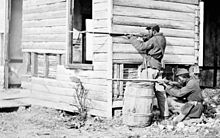Contents







United States Colored Troops (USCT) were Union Army regiments during the American Civil War that primarily comprised African Americans, with soldiers from other ethnic groups also serving in USCT units. Established in response to a demand for more units from Union Army commanders, USCT regiments, which numbered 175 in total by the end of the war in 1865, constituted about one-tenth of the manpower of the army, according to historian Kelly Mezurek, author of For Their Own Cause: The 27th United States Colored Troops. "They served in infantry, artillery, and cavalry." Approximately 20 percent of USCT soldiers were killed in action or died of disease and other causes, a rate about 35 percent higher than that of white Union troops. Numerous USCT soldiers fought with distinction, with 16 receiving the Medal of Honor. The USCT regiments were precursors to the Buffalo Soldier units which fought in the American Indian Wars.

The African American Civil War Memorial Museum, in the U Street district of Washington, D.C., recognizes the contributions of the 209,145 members of the United States Colored Troops (USCT). The eponymous memorial, dedicated in July 1998 by the African American Civil War Memorial Freedom Foundation, commemorates the service of 209,145 African-American soldiers and about 7,000 white and 2,145 Hispanic soldiers, together with the approximate 20,000 unsegregated Navy sailors, who fought for the Union in the American Civil War, mostly among the 175 regiments of United States Colored Troops.
The following units of the German First Army and British Expeditionary Force fought in the Battle of Mons in World War I.
The following units and commanders fought in the Battle of Northern and Eastern Henan.
This is the order of battle for the First Battle of Ypres fought from 19 October to 22 November 1914 as one of the main engagements of the First World War. It was fought between mixed British Expeditionary Force, French eighth army and armies of the German Empire in northern France and Flanders.

This is the order of battle for the ground campaign in the Gulf War between U.S. and Coalition Forces and the Iraqi Armed Forces between February 24–28, 1991. The order that they are listed in are from west to east. Iraqi units that were not in the Kuwaiti Theater of Operations are excluded from this list. Some Iraqi divisions remained un-identified by Department of Defense intelligence and a number of the details of the Iraqi order of battle are in dispute among various authoritative sources.